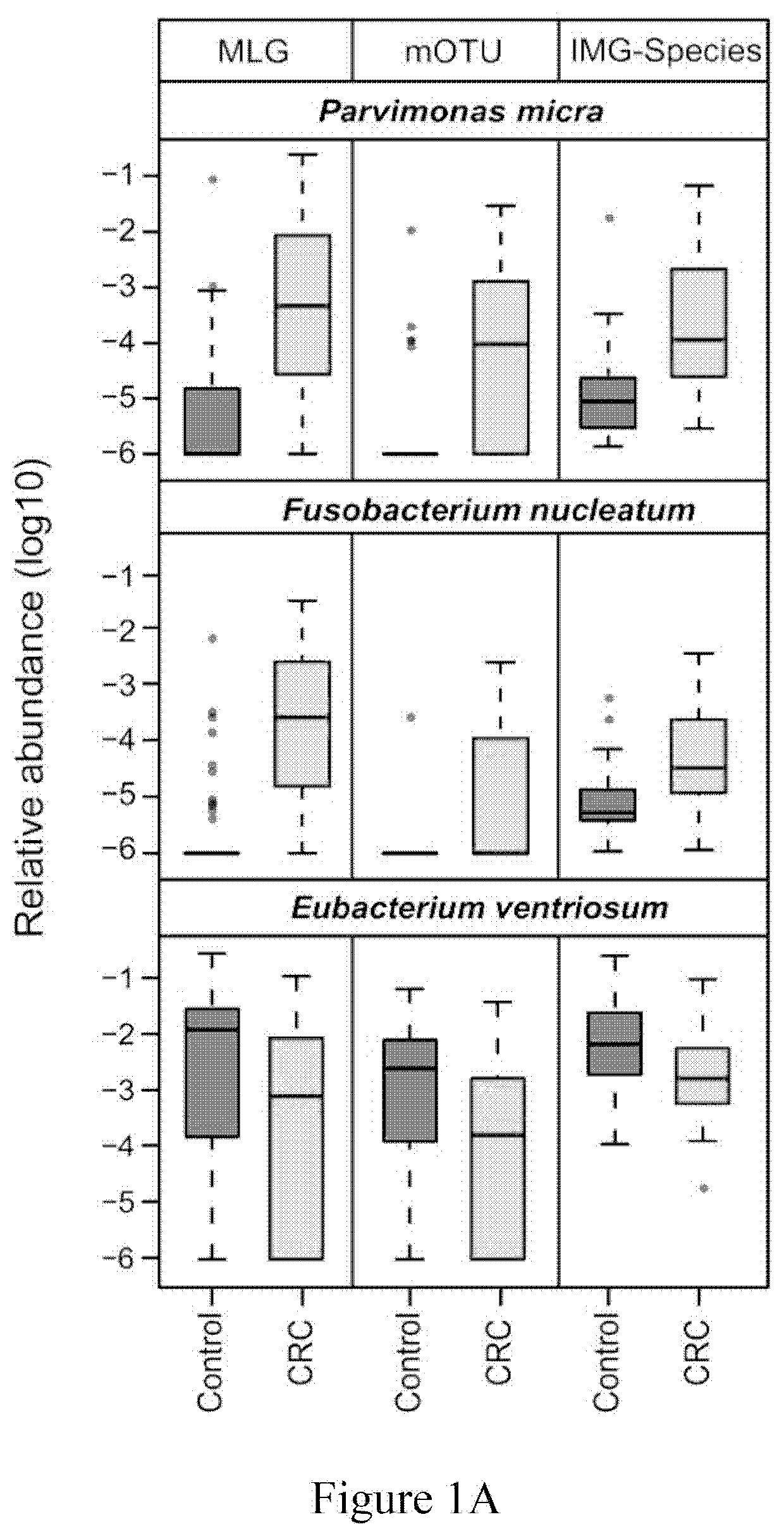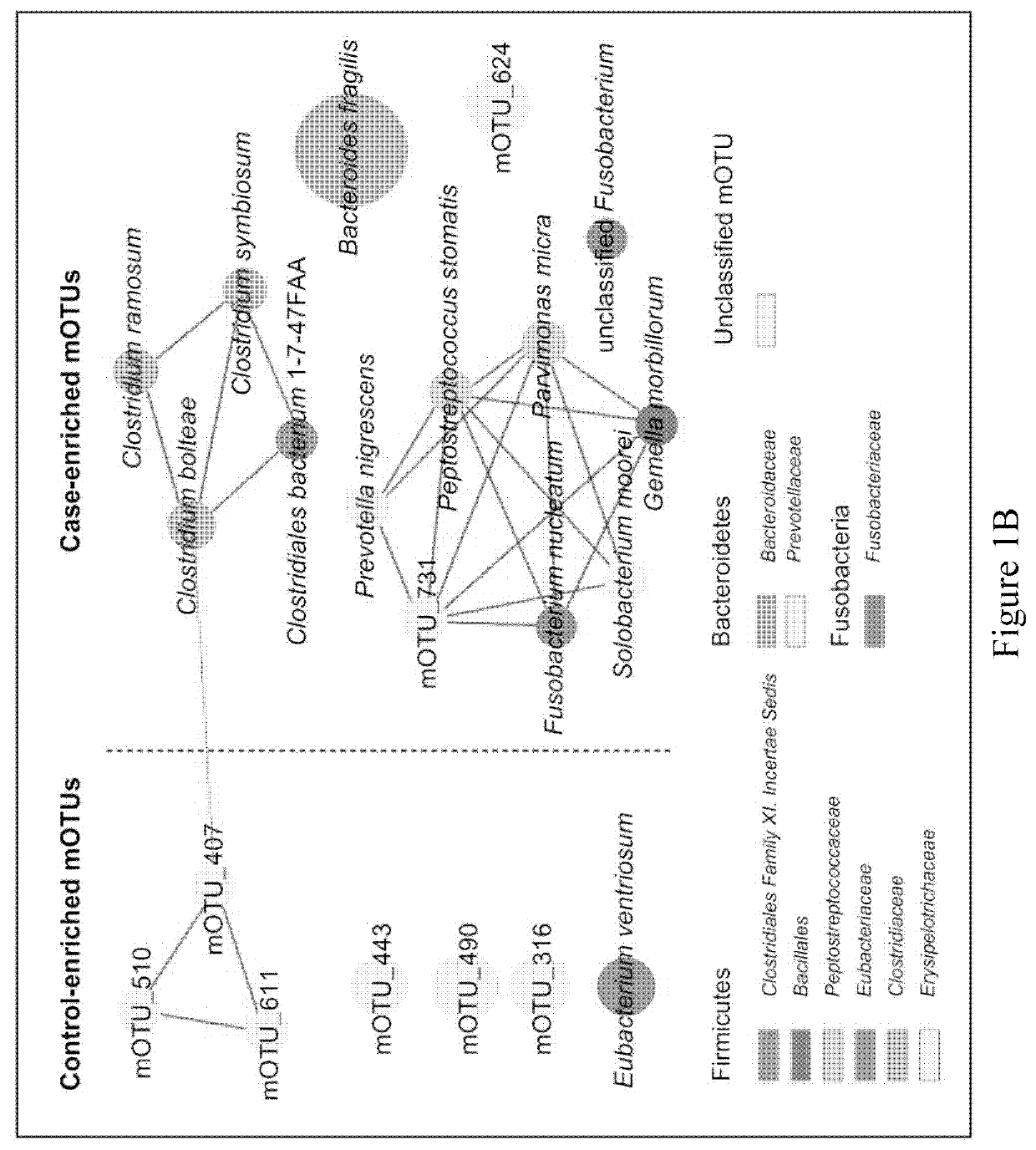Fecal bacterial markers for colorectal cancer
a colorectal cancer and bacterial technology, applied in the field of fecal bacterial markers for colorectal cancer, can solve the problems of difficult colorectal cancer diagnosis, low detection efficiency, and inability to accurately detect colorectal cancer, so as to reduce the risk of crc and increase the risk of recurren
- Summary
- Abstract
- Description
- Claims
- Application Information
AI Technical Summary
Benefits of technology
Problems solved by technology
Method used
Image
Examples
example 1
REFERENCES FOR EXAMPLE 1
[0318]1. Ferlay J, Soerjomataram I, Ervik M, et al. GLOBOCAN 2012 v1.0, Cancer Incidence and Mortality Worldwide. IARC CancerBase. Lyon, France: International Agency for Research on Cancer, 2013.[0319]2. Galvan A, Ioannidis J P, Dragani T A. Beyond genome-wide association studies: genetic heterogeneity and individual predisposition to cancer. Trends Genet 2010; 26:132-41.[0320]3. Lichtenstein P, Holm N V, Verkasalo P K, et al. Environmental and heritable factors in the causation of cancer—analyses of cohorts of twins from Sweden, Denmark, and Finland. N Engl J Med 2000; 343:78-85.[0321]4. Foulkes W D. Inherited susceptibility to common cancers. N Engl J Med 2008; 359:2143-53.[0322]5. Dove W F, Clipson L, Gould K A, et al. Intestinal neoplasia in the ApcMin mouse: independence from the microbial and natural killer (beige locus) status. Cancer Res 1997; 57:812-14.[0323]6. Arthur J C, Perez-Chanona E, Muhlbauer M, et al. Intestinal inflammation targets cancer-in...
example 2
REFERENCES FOR EXAMPLE 2
[0366]1. Sung J J, Lau J Y, Goh K L, et al. Increasing incidence of colorectal cancer in Asia: implications for screening. Lancet Oncol 2005; 6:871-6.[0367]2. Irrazabal T, Belcheva A, Girardin S E, et al. The multifaceted role of the intestinal microbiota in colon cancer. Mol Cell 2014; 54:309-20.[0368]3. Ahn J, Sinha R, Pei Z, et al. Human gut microbiome and risk for colorectalcancer. J Natl Cancer Inst 2013; 105:1907-11.[0369]4. Kassinen A, Krogius-Kurikka L, Makivuokko H, et al. The fecal microbiota of irritable bowel syndrome patients differs significantly from that of healthy subjects. Gastroenterology 2007; 133:24-33.[0370]5. Castellarin M, Warren R L, Freeman J D, et al. Fusobacterium nucleatum infection is prevalent in human colorectal carcinoma. Genome Res 2012; 22:299-306.[0371]6. Qin J, Li Y, Cai Z, et al. A metagenome-wide association study of gut microbiota in type 2 diabetes. Nature 2012; 490:55-60.[0372]7. Shin N R, Lee J C, Lee H Y, et al. An ...
PUM
| Property | Measurement | Unit |
|---|---|---|
| concentrations | aaaaa | aaaaa |
| concentrations | aaaaa | aaaaa |
| Tm | aaaaa | aaaaa |
Abstract
Description
Claims
Application Information
 Login to View More
Login to View More - R&D
- Intellectual Property
- Life Sciences
- Materials
- Tech Scout
- Unparalleled Data Quality
- Higher Quality Content
- 60% Fewer Hallucinations
Browse by: Latest US Patents, China's latest patents, Technical Efficacy Thesaurus, Application Domain, Technology Topic, Popular Technical Reports.
© 2025 PatSnap. All rights reserved.Legal|Privacy policy|Modern Slavery Act Transparency Statement|Sitemap|About US| Contact US: help@patsnap.com



